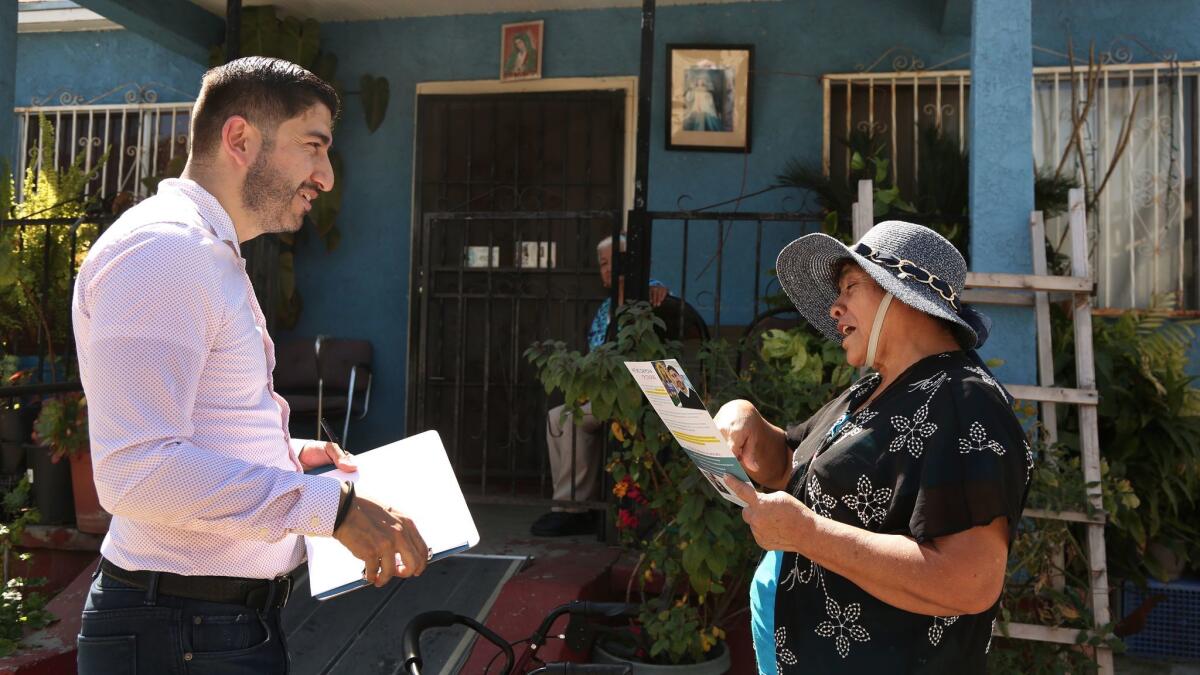Low voter turnout could make this California congressional race an election for friends and insiders

- Share via
Just as the campaign for L.A.’s only open congressional seat this year began to intensify, Los Angeles Mayor Eric Garcetti had a warning.
“Trust me, this will be a low-turnout election,” Garcetti said a few weeks ago at a campaign kickoff event for Assemblyman Jimmy Gomez, a Democrat he already had endorsed. “Do not take this for granted. This is a very crowded field … and the people who bring out the most of their friends will win.”
For months, Gomez and the rest of the 24 candidates running in this central L.A. district have been trying to do just that. With 20 Democrats running in a left-leaning district and little daylight between their mostly progressive platforms, the candidates’ focus has been on the shoe-leather campaigning that’s needed to win over small groups of voters and get them to the polls.
They’ve hosted neighborhood coffees, organized happy hours and trekked up hills in Mount Washington, trying to reach as many voters as they can in the district’s 48 square miles, which wind through downtown, Koreatown and much of the city’s northeast corridor.
Some have predicted that participation by the 34th District’s 305,000 voters in the April 4 special primary might linger in the single digits, while others say it could be closer to the 20% turnout of L.A.’s March city races.
But political observers and candidates agree: With two dozen hopefuls in the race vying to at least finish in the top two, every vote has the potential to determine the result.
The largest group of voters may be people the candidates already know — people who are engaged enough to even be aware a special election is happening. They’re also the kind of folks who are more likely to be party insiders and following local politics closely.
“They’re people who are involved in their neighborhood associations, they’re involved in their school, they’re civically engaged. They’re the kind of people who feel guilty not voting,” said Paul Mitchell, who runs data firm Political Data Inc.
Though the noisy liberal protests inspired by the Trump presidency suggest there’s renewed excitement among those kinds of likely voters, there are plenty of reasons to be pessimistic about the prospects for overall turnout in this race.
Off-year elections often are plagued by low turnout simply because voters don’t know or care much about the little-publicized contests. This district, represented for more than two decades by Democrat Xavier Becerra before he vacated it to become California’s attorney general, has ranked among the lowest in voter turnout statewide in the last several years.
And the April 4 election date, which is sandwiched between two unrelated city elections, has caused confusion. When one woman urged her Twitter followers to vote for Wendy Carrillo on March 7, the Democrat had to correct her: “My election is actually April 4!” Carrillo wrote.
Voters who got their congressional election ballots just after the March city races complained about receiving them too late, until they realized they were intended for next month’s race.
The condensed timeline for the special election has left candidates, many of them unknown newcomers, with the burden of introducing themselves, persuading voters and informing them about the election’s existence all at once, says Carolyn Riggs, campaign manager for Tracy Van Houten, a 34-year-old Democrat and aerospace engineer who has pitched her roots in science as an asset in tackling issues like climate change and infrastructure.
“It’s like a fierce hunt for voters,” said Arturo Carmona, 38, as he went door to door in Boyle Heights on a recent warm afternoon. Reaching through the black iron gate at one house, Carmona shook hands with Estela Quezada and delivered his pitch. His eyes widened when she told him she was one of five registered voters living in the home.
In an election that could be decided with as few as 30,000 votes, “that’s huge,” he said.
Carmona, Van Houten and many of the Democrats they face have vowed to fight deportations of immigrants in the U.S. illegally and want to protect the Affordable Care Act from Republicans.
They share something else: In a top-two primary where the 42-year-old Gomez holds an advantage in name recognition, the unspoken goal for many is to clinch a spot and go head-to-head with the Democratic assemblyman in a runoff June 6. (In the unlikely event a candidate wins more than 50% of the vote, that candidate would win the election outright and there would not be a runoff.)
The simple basic math if those Republicans come out to vote is that they are going to be 12% of the electorate.
— Paul Mitchell, Political Data Inc.
“This is a two-part race,” Democrat Sara Hernandez said at a gathering Sunday, where about a dozen supporters sipped white wine and ate cupcakes in an airy downtown apartment.
Hernandez, who casts herself as a former teacher who can bridge the disconnect between policymaking and its effect on people’s lives, has the same challenge as the rest of her opponents: building up enough support in a splintered liberal field to squeak into a runoff. That would defy conventional campaign wisdom, which suggests the lone Republican in the race has a better chance of breaking from the pack because so many Democrats are splitting the vote.
While Republicans make up just 9% of registered voters in the 34th District, GOP voters are known to turn out more heavily, especially in low-turnout elections.
“The simple basic math if those Republicans come out to vote is that they are going to be 12% of the electorate,” which could be enough to carry perennial candidate William “Rodriguez” Morrison to the runoff, Mitchell said. In especially low-turnout elections, Mitchell said, voters tend to be older, whiter, more conservative and much more partisan.
Any top progressive vote-getter to face Morrison is almost certain to coast to election in June.
Robert Ahn, the only Korean American candidate in the race, is trying to change that picture. His campaign has focused on registering new voters, particularly within the Korean American community. Since January, his volunteers and staffers say they have registered more than 650 voters.
“Six hundred voters could flip this election,” Mitchell said. And there’s some indication Ahn’s strategy is paying off.
In mail-in ballots turned in so far, more than a quarter of votes were cast by Koreans, based on Political Data’s analysis of surnames, birthplace and translated ballot materials. Koreans make up just 6% of registered voters in the district.
With just over a week to go before the election, 10,841 voters already had mailed in ballots, more than twice the rate voters in the district turned in ballots for the March 7 election.
Of those early voters, a whopping 43% did not vote in the most recent city election, and more than a third are new voters who have been registered only since 2016.
It’s not clear yet whether that could spell higher turnout. An explanation, Mitchell said, is that having just one question on the ballot might encourage voters to turn in their ballots earlier.
Douglas Herman, a Democratic strategist, said those kinds of numbers suggest only that the election will overwhelmingly be decided by mail-in ballots. He expects no significant bump in overall turnout.
“I don’t see any indications that this is a barn-burner turnout in this election,” he said.
Trying to buck that prediction has proved challenging for candidates.
Carmona, after chatting at length with Consuelo Lopez, 71, and her husband, Conrado, was assured after Consuelo told him in Spanish, “My vote is with you.”
But as he turned to go, Lopez waved from her porch: “Esto es para distrito catorce, no?” — “This is for District 14, right?” Consuelo asked, referring to the City Council district in which she lives.
“No,” Carmona corrected her. “This is District 34, for Congress.”
For more on California politics, follow @cmaiduc.
ALSO
Here’s what 23 candidates in L.A.’s congressional race say on the top issues
Could Gov. Jerry Brown be the new face of an anti-nukes campaign? He’s thinking about it
FBI is investigating San Diego-area Rep. Duncan Hunter for possible campaign finance violations
Updates on California politics
UPDATES:
March 24, 11:50 a.m.: This article was updated with new numbers of returned mail ballots in the race and with an updated number of candidates running.
This article was originally published at 10:15 a.m. March 23.
More to Read
Get the L.A. Times Politics newsletter
Deeply reported insights into legislation, politics and policy from Sacramento, Washington and beyond. In your inbox three times per week.
You may occasionally receive promotional content from the Los Angeles Times.











